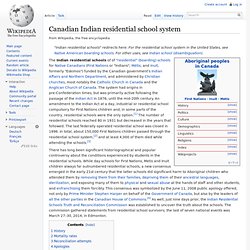

Long-term Impacts. The Legacy of Indian Residential Schools - The Canadian Taxpayers Federation. Last week, Indian and Northern Affairs Minister Jim Prentice stated a final compensation package for Indian residential school survivors was only days away.

But rather than rushing through a deal brokered by the previous government, Prentice should re-consider the "common experience payments". Last year the previous federal government announced they signed an agreement with the Assembly of First Nations to negotiate a $1.9-billion lump sum payout to all - approximately 86,000 - living former students of Indian residential schools. The "common experience payment" of $10,000 would be paid all former students.
By signing the agreement, the federal government signals that all residential schools were bad and no student ever benefited from attending them. The idea of residential schools being systematically horrendous can be heard in the words of aboriginal leader and professor Phil Lane. But is this really the case Even aboriginal support for the system persisted long into the 20th century.
Canadian Indian residential school system. There has long been significant historiographical and popular controversy about the conditions experienced by students in the residential schools.

While day schools for First Nations, Metis and Inuit children always far outnumbered residential schools, a new consensus emerged in the early 21st century that the latter schools did significant harm to Aboriginal children who attended them by removing them from their families, depriving them of their ancestral languages, sterilization, and exposing many of them to physical and sexual abuse at the hands of staff and other students, and enfranchising them forcibly. History[edit] The foundations of the system were the pre-confederation Gradual Civilization Act (1857) and the Gradual Enfranchisement Act (1869). These assumed the inherent superiority of British ways, and the need for Indians to become English-speakers, Christians, and farmers. At the time, many Aboriginal leaders wanted these acts overturned.[9] St. Mortality rates[edit]
Hidden from History: The Canadian Holocaust - Chronology of Events. 1857: The Gradual Civilization Act is passed by the Legislature of Upper Canada, permanently disenfranchising all Indian and Metis peoples, and placing them in a separate, inferior legal category than citizens. 1874: The Indian Act is passed in Canada’s Parliament, incorporating the inferior social status of native people into its language and provisions.

Aboriginals are henceforth imprisoned on reserve lands and are legal wards of the state. 1884: Legislation is passed in Ottawa creating a system of state-funded, church administered Indian Residential Schools. 1905: Over one hundred residential schools are in existence across Canada, 60% of them run by the Roman Catholics. 1907: Dr. November 15, 1907: Bryce’s report is quoted in The Ottawa Citizen’s headline. 1908-1909: Duncan Campbell Scott, Superintendent of Indian Affairs, suppresses Bryce’s report and conducts a smear and cover-up campaign regarding its findings.
The lawsuit seeks an injunction banning Rev. November 1, 2002 - Rev.